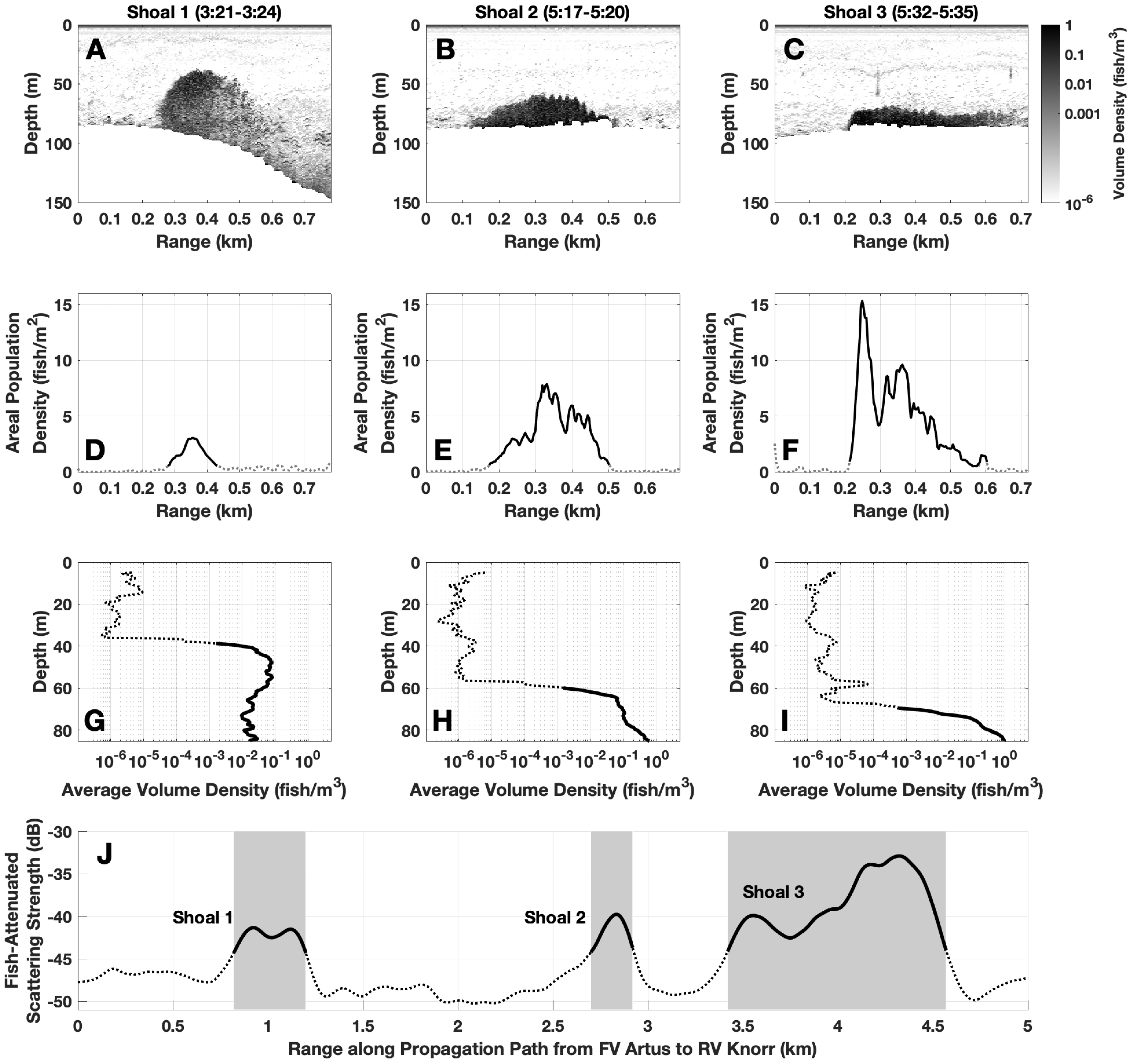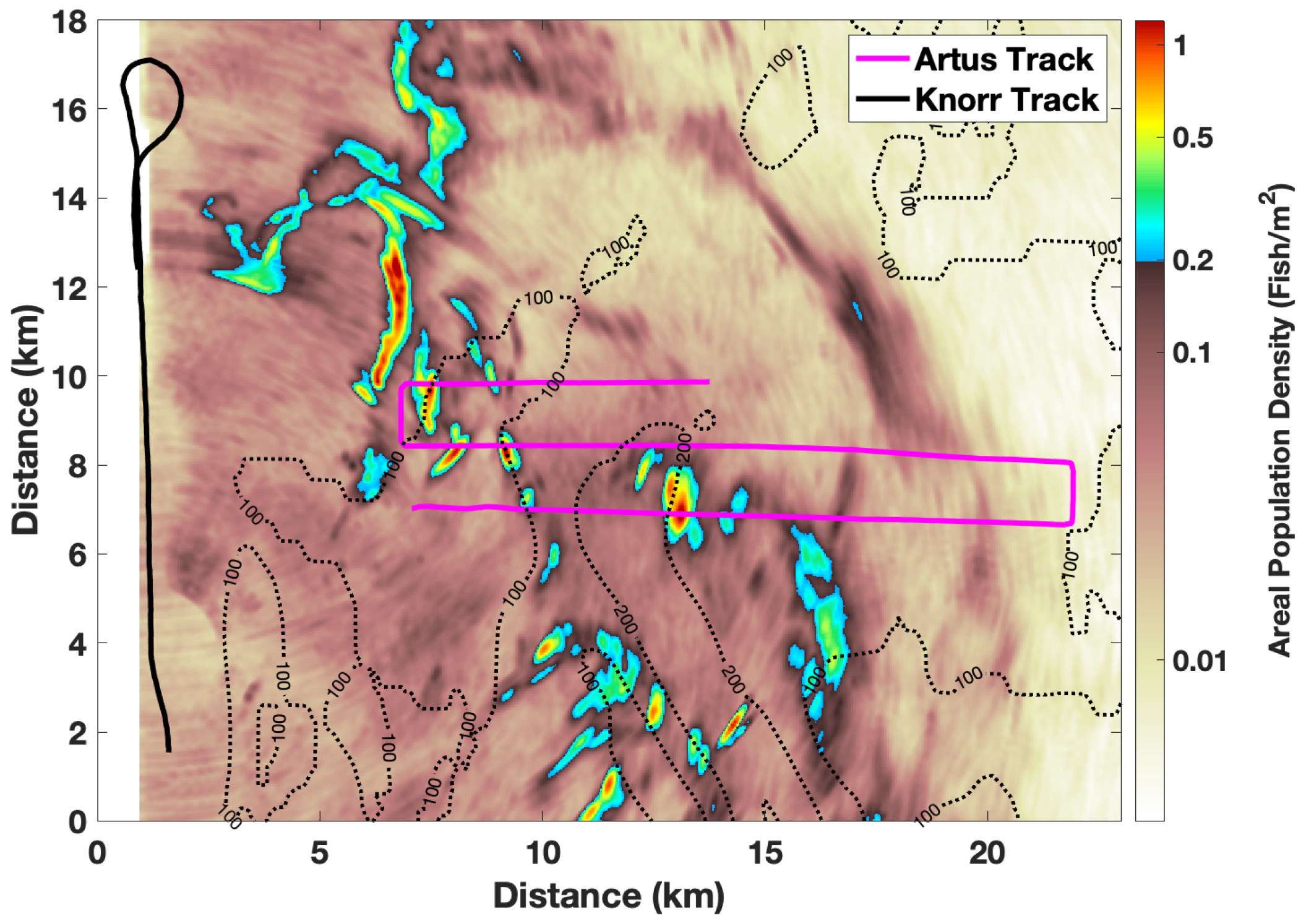The Effect of Attenuation from Fish on Passive Detection of Sound Sources in Ocean Waveguide Environments
Abstract
:1. Introduction
2. Materials and Methods
2.1. Measuring Reductions in Ship Tonal Intensity Due to Fish-Attenuation
2.2. Predicting Reductions in Ship Tonal Intensity Due to Fish-Attenuation
3. Results
4. Discussion
5. Conclusions
Author Contributions
Funding
Conflicts of Interest
Appendix A. OAWRS Measurements of Herring Population Density

Appendix B. Estimating the Probability Density Function of Herring Depth

Appendix C. Identifying Detections of Ship-Radiated Tonals

Appendix D. Estimating Artus Source Level

Appendix E. Sound Speed Profiles

References
- Medwin, H.; Clay, C. Acoustical Oceanography; John Wiley Sons Inc.: New York, NY, USA, 1977. [Google Scholar]
- Urick, R. Principles of Underwater Sound; McGraw Hill: New York, NY, USA, 1983. [Google Scholar]
- Wang, D.; Garcia, H.; Tran, D.D.; Jain, A.D.; Yi, D.H.; Gong, Z.; Jech, J.M.; Godø, O.R.; Makris, N.C.; Ratilal, P. Vast assembly of vocal marine mammals from diverse species on fish spawning ground. Nature 2016, 531, 366–369. [Google Scholar] [CrossRef]
- Weston, D.; Stevens, K.; Revie, J.; Pengelly, M. Multiple frequency studies of sound transmission fluctuations in shallow water. J. Sound. Vib. 1971, 18, 487–497. [Google Scholar] [CrossRef]
- Ching, P.; Weston, D. Wideband studies of shallow-water acoustic attenuation due to fish. J. Sound. Vib. 1971, 18, 499–510. [Google Scholar] [CrossRef]
- Diachok, O. Effects of absorptivity due to fish on transmission loss in shallow water. J. Acoust. Soc. Am. 1999, 105, 2107–2128. [Google Scholar] [CrossRef]
- Diachok, O.; Liorzou, B.; Scalabrin, C. Estimation of the number density of fish from resonance absorptivity and echo sounder data. ICES J. Mar. Sci. 2001, 58, 137–153. [Google Scholar] [CrossRef] [Green Version]
- Duane, D.; Cho, B.; Jain, A.D.; Godø, O.R.; Makris, N.C. The Effect of Attenuation from Fish Shoals on Long-Range, Wide-Area Acoustic Sensing. Remote Sens. 2019, 11, 2464. [Google Scholar] [CrossRef] [Green Version]
- Garcia, H.A.; Zhu, C.; Schinault, M.E.; Kaplan, A.I.; Handegard, N.O.; Godø, O.R.; Ahonen, H.; Makris, N.C.; Wang, D.; Huang, W.; et al. Temporal–Spatial, Spectral, and Source Level Distributions of Fin Whale Vocalizations in the Norwegian Sea observed with a Coherent Hydrophone Array. ICES J. Mar. Sci. 2019, 76, 268–283. [Google Scholar] [CrossRef]
- Huang, W.; Wang, D.; Ratilal, P. Diel and Spatial Dependence of Humpback Song and Non-Song Vocalizations in Fish Spawning Ground. Remote Sens. 2016, 8, 712. [Google Scholar] [CrossRef] [Green Version]
- Wang, D.; Huang, W.; Garcia, H.; Ratilal, P. Vocalization Source Level Distributions and Pulse Compression Gains of Diverse Baleen Whale Species in the Gulf of Maine. Remote Sens. 2016, 8, 881. [Google Scholar] [CrossRef] [Green Version]
- Gong, Z.; Jain, A.D.; Yi, D.H.; Wu, F.; Zorn, A.; Ratilal, P.; Makris, N.C. Ecosystem Scale Acoustic Sensing Reveals Humpback Whale Behavior Synchronous with Herring Spawning Processes and Re-Evaluation Finds No Effect of Sonar on Humpback Song Occurence in the Gulf of Maine in Fall 2006. PLoS ONE 2014, 9, e104733. [Google Scholar] [CrossRef]
- Tran, D.D.; Huang, W.; Bohn, A.C.; Wang, D. Using a Coherent Hydrophone Array for Observing sperm Whale Range, Classification, and Shallow-Water Dive Profiles. J. Acoust. Soc. Am. 2014, 135, 3352–3363. [Google Scholar] [CrossRef] [PubMed] [Green Version]
- Huang, W.; Wang, D.; Garcia, H.; Godø, O.R.; Ratilal, P. Continental Shelf-Scale Passive Acoustic Detection and Characterization of Diesel-Electric Ships Using a Coherent Hydrophone Array. Remote Sens. 2017, 9, 772. [Google Scholar] [CrossRef] [Green Version]
- Zhu, C.; Garcia, H.; Kaplan, A.; Schinault, M.; Handegard, N.O.; Godø, O.R.; Huang, W.; Ratilal, P. Detection, Localization and Classification of Multiple Mechanized Ocean Vessels over Continental-Shelf Scale Regions with Passive Ocean Acoustic Waveguide Remote Sensing. Remote Sens. 2018, 10, 1699. [Google Scholar] [CrossRef] [Green Version]
- Zhu, C.; Seri, S.G.; Mohebbi-Kalkhoran, H.; Ratilal, P. Long-Range Automatic Detection, Acoustic Signature Characterization and Bearing-Time Estimation of Multiple Ships with Coherent Hydrophone Array. Remote Sens. 2020, 12, 3731. [Google Scholar] [CrossRef]
- Tran, D.D.; Andrews, M.; Ratilal, P. Probability Distribution for Energy of Saturated Broadband Ocean Acoustic Transmission: Results from Gulf of Maine 2006 Experiment. J. Acoust. Soc. Am. 2012, 132, 3659–3672. [Google Scholar] [CrossRef]
- Ratilal, P.; Makris, N.C. Mean and covariance of the forward field propagated through a stratified ocean waveguide with three-dimensional random inhomogeneities. J. Acoust. Soc. Am. 2004, 118, 3532–3558. [Google Scholar] [CrossRef]
- Chen, T.; Ratilal, P.; Makris, N.C. Mean and variance of the forward field propagated through three-dimensional random internal waves in a continental-shelf waveguide. J. Acoust. Soc. Am. 2005, 118, 3560–3574. [Google Scholar] [CrossRef]
- Chen, T.; Ratilal, P.; Makris, N.C. Temporal coherence after multiple forward scattering through random three-dimensional inhomogeneities in an ocean waveguide. J. Acoust. Soc. Am. 2008, 124, 2812–2822. [Google Scholar] [CrossRef]
- Gong, Z.; Chen, T.; Ratilal, P.; Makris, N.C. Temporal coherence of the acoustic field forward propagated through a continental shelf with random internal waves. J. Acoust. Soc. Am. 2013, 134, 3476–3485. [Google Scholar] [CrossRef] [PubMed] [Green Version]
- Cho, B.; Makris, N.C. Predicting the effects of random ocean dynamic processes on underwater acoustic sensing and communication. Sci. Rep. 2020, 10, 4525. [Google Scholar] [CrossRef]
- Collins, M. A split-step Padé solution for the parabolic equation method. J. Acoust. Soc. Am. 1993, 93, 1736–1742. [Google Scholar] [CrossRef]
- Andrews, M.; Chen, T.; Ratilal, P. Empirical dependence of acoustic transmission scintillation statistics on bandwidth, frequency, and range in New Jersey continental shelf. J. Acoust. Soc. Am. 2009, 125, 111–124. [Google Scholar] [CrossRef]
- Makris, N.C.; Ratilal, P.; Jagannathan, S.; Gong, Z.; Andrews, M.; Bertsatos, I.; Godø, O.; Nero, R.; Jech, J.M. Critical population density triggers rapid formation of vast oceanic fish shoals. Science 2009, 323, 1734–1737. [Google Scholar] [CrossRef] [Green Version]
- Makris, N.C.; Ratilal, P.; Symonds, D.; Jagannathan, S.; Lee, S.; Nero, R. Fish population and behavior revealed by instantaneous continental shelf-scale imaging. Science 2006, 311, 660–663. [Google Scholar] [CrossRef]
- Jagannathan, S.; Bertsatos, I.; Symonds, D.; Chen, T.; Nia, H.; Jain, A.; Andrews, M.; Gong, Z.; Nero, R.; Ngor, L.; et al. Ocean Acoustics Waveguide Remote Sensing (OAWRS) of marine ecosystems. Mar. Ecol. Prog. Ser. 2009, 395, 137–160. [Google Scholar] [CrossRef]
- Gong, Z.; Andrews, M.; Jagannathan, S.; Patel, R.; Jech, J.M.; Makris, N.C.; Ratilal, P. Low-frequency target strength and abundance of shoaling Atlantic herring (Clupea Harengus) Gulf Maine Ocean Acoust. Waveguide Remote Sens. 2006 Exp. J. Acoust. Soc. Am. 2010, 127, 104–123. [Google Scholar] [CrossRef]
- Dyer, I. Statistics of Sound Propagation in the Ocean. J. Acoust. Soc. Am. 1970, 48, 337–345. [Google Scholar] [CrossRef]
- Makris, N.C. The effect of saturated transmission scintillation on ocean acoustic intensity measurements. J. Acoust. Soc. Am. 1996, 100, 769–783. [Google Scholar] [CrossRef]
- Yi, D.H.; Makris, N.C. Feasibility of Acoustic Remote Sensing of Large Herring Shoals and Seafloor by Baleen Whales. Remote Sens. 2016, 8, 693. [Google Scholar] [CrossRef] [Green Version]
- Johnson, M.; Madsen, P.T.; Zimmer, W.M.X.; de Soto, N.A.; Tyack, P.L. Beaked whales echolocate on prey. Proc. Biol. Sci. 2004, 271, 2239–2247. [Google Scholar] [CrossRef] [PubMed]
- Makris, N.C.; Godø, O.R.; Yi, D.H.; Macauley, G.J.; Jain, A.D.; Cho, B.; Gong, Z.; Jech, J.M.; Ratilal, P. Instantaneous areal population density estimation of entire Atlantic cod and herring spawning groups and group size distribution relative to total spawning population. Fish Fish. 2018, 20, 1–13. [Google Scholar]
- Wang, D.; Ratilal, P. Angular resolution enhancement provided by nonuniformly-spaced linear hydrophone arrays in ocean acoustic waveguide remote sensing. Remote Sens. 2017, 9, 1036. [Google Scholar] [CrossRef] [Green Version]
- Makris, N.C. A foundation for logarithmic measures of fluctuating intensity in pattern recognition. Opt. Lett. 1995, 20, 2012–2014. [Google Scholar] [CrossRef]
- Trevorrow, M.V.; Vasiliev, B. Directionality and maneuvering effects on a surface ship underwater acoustic signature. J. Acoust. Soc. Am. 2008, 124, 767. [Google Scholar] [CrossRef] [Green Version]
- Wang, L.S.; Robinson, S.P.; Theobald, P. Measurement of radiated ship noise. Proc. Mtgs. Acoust. 2012, 17, 070091. [Google Scholar]








| Areal Density (Fish/m2) | Shoal Depth (m) | Shoal Vertical Thickness (m) | Distance Along Propagation Path (km) | Shoal Horizontal Thickness (km) | |
|---|---|---|---|---|---|
| Shoal 1 | 1.7 | 62.5 | 45 | 1.01 | 0.38 |
| Shoal 2 | 3.7 | 72.5 | 25 | 2.81 | 0.22 |
| Shoal 3 | 5.1 | 77.5 | 15 | 3.99 | 1.15 |
| Environment/Species | Areal Density (Fish/m2) | Water Depth (m) | Shoal Depth (m) | Shoal Vertical Thickness (m) | Neutral Buoyancy Depth (m) | Mean Fish Length (cm) |
|---|---|---|---|---|---|---|
| Gulf of Maine herring | 2 a | 200 a | 150 a | 30 a | 82 a | 24 a |
| Finnmark capelin | 10 b | 300 b | 30 b | 40 b | 10 c | 17 d |
| Ålesund herring | 2 e | 120 e | 80 d | 80 d | 3 e | 34 d |
Publisher’s Note: MDPI stays neutral with regard to jurisdictional claims in published maps and institutional affiliations. |
© 2021 by the authors. Licensee MDPI, Basel, Switzerland. This article is an open access article distributed under the terms and conditions of the Creative Commons Attribution (CC BY) license (https://creativecommons.org/licenses/by/4.0/).
Share and Cite
Duane, D.; Zhu, C.; Piavsky, F.; Godø, O.R.; Makris, N.C. The Effect of Attenuation from Fish on Passive Detection of Sound Sources in Ocean Waveguide Environments. Remote Sens. 2021, 13, 4369. https://doi.org/10.3390/rs13214369
Duane D, Zhu C, Piavsky F, Godø OR, Makris NC. The Effect of Attenuation from Fish on Passive Detection of Sound Sources in Ocean Waveguide Environments. Remote Sensing. 2021; 13(21):4369. https://doi.org/10.3390/rs13214369
Chicago/Turabian StyleDuane, Daniel, Chenyang Zhu, Felix Piavsky, Olav Rune Godø, and Nicholas C. Makris. 2021. "The Effect of Attenuation from Fish on Passive Detection of Sound Sources in Ocean Waveguide Environments" Remote Sensing 13, no. 21: 4369. https://doi.org/10.3390/rs13214369






